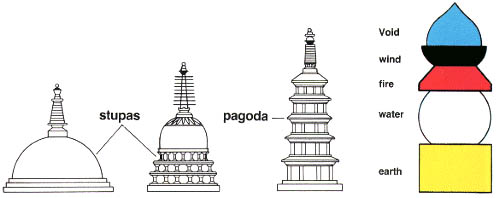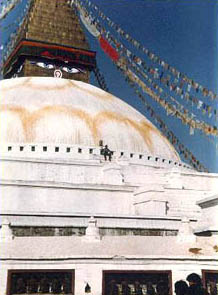

The stupa itself has been around since pre-Buddhist times and even prehistoric times dating from about 2000 BCE. These ancient buildings contained remains of heroes, saints, kings, and other heroes from those times. It was said that they housed the souls and spirits of these prominent figures of society. The ancient stupas were built simply with rock and earth and were considered to be burial mounds. Some stupas in northern India, around 100 BCE, were carved inside caves.
Although the structure of the stupa is
not complex, there is meaning in each part of the architecture. Originally
made of wood, the vedika today is a square-shaped stone fence that
surrounds the entire stupa. This fence represents keeping the profane
outside from the sacred things that are inside. The torana are the
gates that appear on each side of the fence. These gates are open to the
four quarters of the world and correspond to the sunrise, zenith, sunset,
and the nadir. The torana are meant for people to "come and
see". The pradasina is the area between the fence and the
stupa and is used for ritual during the course of the sun. The shadows in
the pradasina indicate the following: east - Buddha's birth; south
- His Enlightenment; west - His wheel of law; and north - Buddha's final
liberation. Within the fences of the stupa, there are steps. These
thirteen steps of enlightenment represent the element of fire.
Next, the foundation, or trimala, of the stupa represents the element of earth or the underworld. Also, many stupa foundations are in three steps, such as the Ruvanveli Dagoba in Anuradhapura. The most impressive part of the Buddhist stupa is the dome, or anda. The anda represents creative power, the element of water, and the infinite dome of heaven. Also represented is the cycle of death and rebirth. Going up again from the anda is the harmika. The harmika looks like a stone altar and represents the sacrifices that humans must make in order to reach nirvana. The harmika also symbolizes the zenith beyond life and death which is nirvana. The catta, an umbrella like structure is located directly above the harmika. This structure is similar to the idea of the tree of life or tree of enlightenment and represents the many higher planes of existence.
 The
Buddhist stupa, although not Buddhist in origin, has been around for about
4000 years. Its structure is completely tied in with symbolism of the
divine and concepts of the divine. From foundation to the tip, evidence of
nature religion influence can be seen and shows Buddhist values and
concepts. The stupa, although simply beautiful to look at, is not a simple
piece of architecture at all.
The
Buddhist stupa, although not Buddhist in origin, has been around for about
4000 years. Its structure is completely tied in with symbolism of the
divine and concepts of the divine. From foundation to the tip, evidence of
nature religion influence can be seen and shows Buddhist values and
concepts. The stupa, although simply beautiful to look at, is not a simple
piece of architecture at all.
| Bibliography |
- Ahmed, Naeem. The Buddhist Stupa: Origin and Development. http://www.history.upenn.edu/hist085/sanchi.htm. (1996)(October 25, 2002)
- Buddha Dharma Education Association. http://www.buddhanet.net/stupa.htm. Buddhist Art and Architechture: Symbolism of the Stupa. . (October 25, 2002)
- Govinda, Lama Anargarika. Psycho-Cosmic Symbolism of the Buddhist Stupa. Dharma Publishing: Emeryville, CA. 1976.
- King, Patrick. South Korea: Culture, History, and Religion. http://www.media.granite.k12.ut.us/Curriculum/korea/bud_arch.htm. (October 30, 2002)
| Picture Resources |
- Buddha Dharma Education Association. http://www.buddhanet.net/stupa.htm. Buddhist Art and Architechture: Symbolism of the Stupa. . (October 25, 2002)
- King, Patrick. South Korea: Culture, History, and Religion. http://www.media.granite.k12.ut.us/Curriculum/korea/bud_arch.htm. (October 30, 2002)
- D'Aoust, Gerald. Lotus - Home of the True Tibetan Apso. http://www.tibetanapso.com/ph-stupa.htm. (October 30, 2002)
